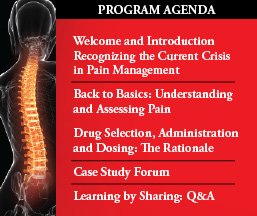
|

|
|
Accreditation Faculty Workshops Point of Care Webcast on Demand Tutorial Live webcast Outcomes Jointly sponsored by University of Kentucky College of Pharmacy and Vemco MedEd  This activity is supported by an educational grant from Janssen Pharmaceuticals, Inc., administered by Janssen Scientific Affairs, LLC 
|
Pain represents a major crisis in today's healthcare environment with over 70 million
Americans experiencing chronic pain each year. Poor management of pain has been linked
to reduced quality of life and patient satisfaction of care. During hospitalization, inadequate
management of pain leads to longer length of stay and higher readmission rates, resulting
in overall higher healthcare costs. Pain places a heavy financial burden on society
and is a leading cause of disability and lost work days.
As health-system pharmacists attempt to implement principles and strategies learned, they will continue to have questions regarding how to incorporate them into clinical practice. Therefore, through Internet Point of Care activity, participants will have access to resources necessary to search for answers to their specific clinical questions |
|
Home
About
Us What
We Do CME
Portal Register
for Programs Outcomes
Reports Contact
Us | Legal | Privacy
Statement |
